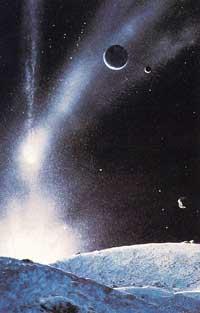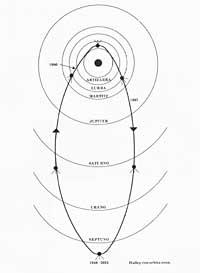Interstellar Dust in the Solar System
1994/11/01 Arregi Bengoa, Jesus Iturria: Elhuyar aldizkaria
However, due to the weakness of the interaction between this radiation and matter, it has not yet been detected.
However, optical telescopes and radio telescopes are not our only connection to interstellar space. As we know the materials dispersed on planets, comets and space, the processes it underwent until its formation are partially memorized in its structure. Therefore, the current abundance of some elements indicates the conditions that occurred in the Universe for hundreds of millions of years after the big-bang.
In recent years, in addition, it seems that a new path has been opened to obtain interesting results from the study of the matter. As in other areas, progress has also come in this area thanks to a satellite. NASA's Long Duration Expasure Facility (LDEF) satellite has been orbiting the Earth from April 1984 to January 1990 to collect some of the meteorites passing by. To do this, the LDEF had a suitable binding in which the battered dust phytes lost their speed and were trapped.
Analyzing the depth and shape of the crater made by the seal can calculate its attack speed. In fact, the values of some of these estimated speeds have sparked debate. J. A. M. For McDonnell, the speed of some of the fractions that hit the LDEF was so high that they should be alien to the Solar System. If this were so, interstellar dust samples would be analyzed, with direct news outside our planetary system. The information we could obtain would have a special impact on the development of the theory of the creation of the Solar System and other planetary systems. In short, some of these meteorites are only the waste generated after the creation of the planetary system. Let's analyze this a little more.

Planetary systems are a consequence of the process of shrinking huge molecular clouds. These clouds break in many parts in the initial phases of contraction, and from each of these parts the star is formed and perhaps the planetary system. As the contraction progresses, most of the matter in the cloud part accumulates in your area, increasing the temperature with pressure.
Thus the protostar is created, and the matter that has not fallen to the place remains around forming a disk. In this disc planets are created from the large parts of matter, due to their shocks and gravitational attraction. Matter that is not part of the planets, perhaps 50% of the disk, is disseminated as residue, forming small bodies such as comets, asteroids or the like, or simply in dust physas.
It is believed that most of these residues are expelled from the region where the newly created planets are found in their path around them, thanks to the acceleration that the gravitational zone produces them. This is an Oort cloud formed by the alleged comets of the Solar System. The radius of this spherical shell, in the case of the Solar System, is about two light years. Therefore, it is incomparable with the average radius of Pluto's orbit, as this is only 5.9 billion km (5.4 light hours). We have no reason to think that in other planetary systems there would be no similar structures. However, comets, and in general most waste, would not remain in the Oort cloud. Some of them would be the ones that would reach us.
It has already been commented that among the dust phytes that have hit the LDEF could have reached higher speeds from a limit, outside the Solar System. We explained the reason almost in the previous paragraph. The fraction that reaches our environment has had to come out of the influence of another star and for this his speed should be greater than the escape speed of the star.
However, not all astronomers agree with McDonnell's conclusions. One of the reasons they mention is: If the dust phytas that have been included in the LDEF have been able to reach here, the larger bodies or comets should also appear in the vicinity of the Sun. According to some calculations, in 150 years we should see about six comets coming from outside the Solar System. Coming from the outside, the orbits of these comets should be hyperbolic, but so far none have been seen. In any case, this problem of interstellar matter has aroused great interest and soon there will be more news. According to most, it cannot be ruled out that interstellar matter can penetrate the Solar System, and astronomers are already developing new pathways for detection. For example, enter the atmosphere and analyze it with radio telescope and radars while burning.
We will mention the last problem to complete the vision of the situation. Once the reliable ways of detecting fractions outside the Solar System are designed, fractions separation criteria will be needed. As mentioned earlier, dust from the outside is not generated in the process of creating planetary systems. An important part is the one emitted in the different phases of the evolution of the stars (red giant, novel...). In this sense, solutions have also been proposed and, in any case, studies continue.
SUN: on November 22 at 13 h 5 min (UT) enters Sagittarius. On November 3 there is a solar eclipse that is not seen from Euskal Herria. MOON: NEW MOON CRESCENT MOON On November 18, at dawn, we have an eclipse of the Moon. It is only light. PLANETS: MERCURY: maximum elongation to the West on day 6. Therefore, we can try to see him at dawn. It is the best option of the year. ARTIZARRA: in conjunction on November 2. Therefore, it is invisible in the surroundings of that day, but in the second half it leaves in the morning. MARIZ: Martitz leaves before midnight (UT) and we can see him in the second half of the night. JUPITER: this month we cannot see it because it is in conjunction on day 17. SATURN: It disappears at midnight, but after dusk we can see it high in the sky. |

Gai honi buruzko eduki gehiago
Elhuyarrek garatutako teknologia






